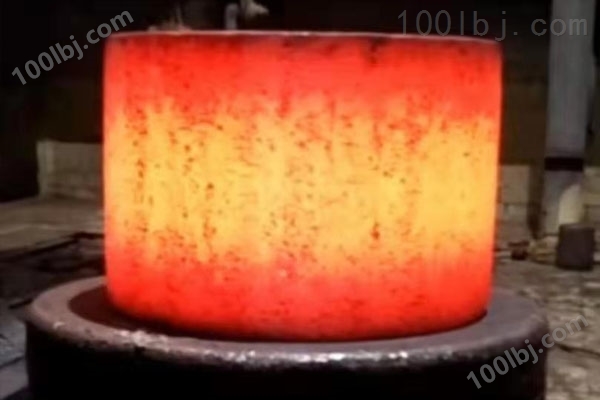自由锻件加工
产品简介
详细信息
锻件热处理淬火时的缺陷及预防措施
1)氧化与脱碳
锻圆厂家的钢在加热时,表面有一层松脆的氧化铁皮的征象称为氧化;脱碳指表面含碳量低落的征象。氧化和脱碳会低落锻件上层的硬度和委靡强度,并且还影响锻件的尺寸。为了防止氧化和脱碳,通常在盐浴炉内加热,要求更高时,可在锻件表面涂覆保护剂或在保护空气及真空中加热。
2)过热和过烧
锻件在淬火加热时.奥氏体晶粒显著粗化的征象称为过热。若加热温度过高,出现晶界氧化并首先片面融化的征象称为过烧。锻件过热,不仅会低落钢的力学机能(尤其是韧性),也容易惹起淬火变形和开裂。过热构造可以用正火处分予以改正,而过烧的锻件只能报废。为了防止锻件的过热和过烧,必须严酷控制加热温度和保温光阴。
3)变形与开裂
锻件淬火冷却时,由于差别部位存在温度差异及构造转变的差别所惹起的应力称为淬火内应力。当淬火应力超过钢的降服强度时,锻件将产生变形;当淬火应力超过钢的抗拉强度时,锻件将产生裂纹而成为垃圾。为了防止锻件的变形和开裂的产生,可采用差别的淬火技巧 (如分级淬火或等温淬火等)和工艺合理的计划措施(如布局对称、斜面匀称、幸免尖角等),尽管削减淬火应力,并在淬火后及时举行回火处分。
4)硬度不及
由于加热温度过低、保温光阴不及、冷却速度不敷大或表面脱碳等缘故变成硬度不及,可采用从新淬火的技巧来消除(但淬火前要举行一次退火或正火处分),并且还须留意以下两点差别。
(1)淬透性与实际锻件的有效淬硬深度的差别。采用同一种钢、差别截面的锻件在一样奥氏体化前提下淬火,其淬透性是相像的,不过其有效淬硬深度却因锻件的样式、尺寸和冷却介质的差别而有差别。淬透性乃是钢本身所固有的特征,关于一种钢,它是确定的,可用于差别钢种之间的对照。而实际工件的有效淬硬深度,它除了取决于钢的淬透性外,还与锻件的样式、尺寸及采用的冷却介质等外界成分相关。
(2)钢的淬透性与淬硬性是两个差别的观点,淬硬性是指钢淬火后能到达的非常高硬度,它要紧取决于马氏体的含碳量。淬透性好的钢其淬硬性不必然高。例如低碳合金钢淬透性相当好,但其淬硬性却不高;高碳钢的淬硬性高,但其淬透性却差。
自由锻件加工哪家好,就找唐山盛通锻造有限公司。
Defects and preventive measures for heat treatment and quenching of forgings
1) Oxidation and decarburization
When the steel of the forged round manufacturer is heated, the surface of the surface has a layer of crunchy iron oxide scale called oxidation; decarburization refers to the sign of low carbon content on the surface. Oxidation and decarburization will lower the hardness and euphemism of the upper layer of the forging and also affect the size of the forging. In order to prevent oxidation and decarburization, it is usually heated in a salt bath furnace. When higher requirements are required, a protective agent may be applied to the surface of the forging or heated in a protective air and a vacuum.
2) Overheating and overburning
When the forging is heated by quenching, the sign of significant coarsening of austenite grains is called overheating. If the heating temperature is too high, the sign of grain boundary oxidation and first melt on one side is called over-burning. Overheating of the forgings not only reduces the mechanical properties of the steel (especially toughness), but also causes quenching deformation and cracking. The overheated structure can be corrected by normalizing the fire, and the overheated forgings can only be scrapped. In order to prevent overheating and overheating of forgings, the heating temperature and the holding time must be strictly controlled.
3) Deformation and cracking
When the forging is quenched and cooled, the stress caused by the difference in temperature and the difference in structural transformation between the different parts is called the internal stress of quenching. When the quenching stress exceeds the falling strength of the steel, the forging will be deformed; when the quenching stress exceeds the tensile strength of the steel, the forging will generate cracks and become garbage. In order to prevent deformation and cracking of forgings, different quenching techniques (such as step quenching or isothermal quenching) and process planning measures (such as layout symmetry, symmetry of the bevel, and sharp corners) can be used, although the quenching stress is reduced. And after the quenching, timely tempering is carried out.
4) less than hardness
Because the heating temperature is too low, the heat preservation time is not enough, the cooling rate is not enough, or the surface decarburization becomes the hardness, it can be eliminated by the new quenching technique (but an annealing or normalizing treatment is performed before quenching), and Be aware of the following two differences.
(1) The difference between the hardenability and the effective hardening depth of the actual forging. The same steel and differential section forgings are quenched under the same austenitizing conditions, and the hardenability is similar, but the effective hardening depth is different due to the difference in the style, size and cooling medium of the forging. Hardenability is an inherent feature of steel itself. For a steel, it is deterministic and can be used for comparison between different steel grades. The effective hardening depth of the actual workpiece, in addition to the hardenability of the steel, is related to the external components such as the style and size of the forging and the cooling medium used.
(2) The hardenability and hardenability of steel are two different viewpoints. Hardenability refers to the very high hardness that steel can reach after quenching, and it depends on the carbon content of martensite. The hardenability of steel with good hardenability is not necessarily high. For example, low carbon alloy steel has a good hardenability, but its hardenability is not high; high carbon steel has high hardenability, but its hardenability is poor.


